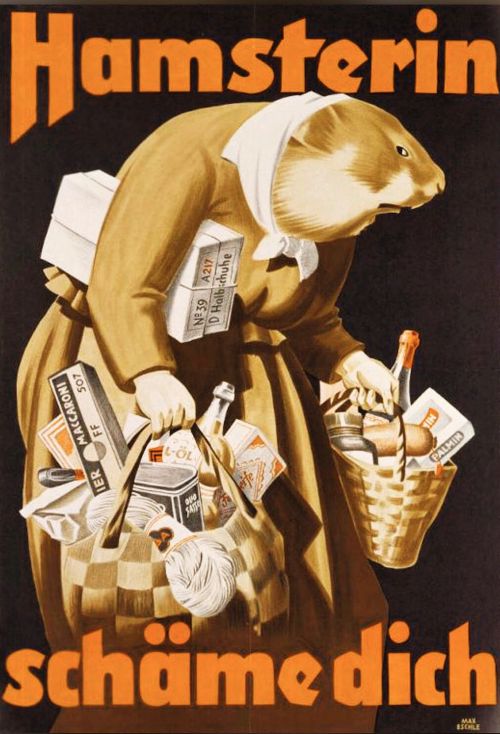
Well. The Great Toiler Paper Famine of 2020 may be subsiding. We got a package of six rolls (one package only!) this morning, and we should have enough now for a couple of weeks.
We have the stores to thank for that. Both Fry’s and Safeway are now limiting quantities on hoardables and even non-hoardables like milk. One per household is the general rule. We know that Fry’s usually gets a truck on Monday nights, so we were there first thing in the morning. Like many other grocers across the country, Fry’s reserves the first hour for people over 60. We got there at 5:50, and there was already a considerable line. At 6 AM sharp, they opened the doors, and everybody made for the toilet paper aisle at a dead run. And lo and behold: Piles and piles of toilet paper! And paper towels. And baby wipes. And rubbing alcohol.
Alas, no bratwurst. What, they’re hoarding bratwursts now?
So we got our one package of TP and one package of paper towels. Carol got a bottle of rubbing alcohol, and a few other things before we ran through Mickey D’s drive-thru for breakfast. All in all, a good and useful morning.
Oh–and at 5:45 AM when we backed out of the garage, I remembered that this morning is Mercury’s maximum elongation, so we jumped out of the Durango and searched for that most-difficult planet. Even at max elongation, the little snot is unholy hard to spot, but spot it we did. (It helps to have few trees and no two-story houses in our neighborhood.) Jupiter, Mars, and Saturn were in a tight little group much higher in the southeast.
The lockdown here in Arizona has been cordial and mostly voluntary. Local government is not harrassing people who walk for exercise. My barber shop closed last Thursday, but others are still open, so if I get a little too pointy-haired, I have options. The Jewish Community Center is closed, so we’re not doing our usual weight training every Monday. I’m going to buy an 18-pound ketttlebell if I can find a store still selling 18-pound kettlebells. You can do a lot with an 18-pound kettlebell. We had to cancel our writers’ workshop because restaurants can’t provide indoor or patio seating. We meet in a biggish sandwich place, so we’re out of luck. We’re trying to figure out a reliable teleconferencing system for the interim.
We no longer go to Costco. That’s a shame, since I like their frozen blueberries, but with conventional grocery stores limiting quantities to stop hoarding, all the hamsterin’ is now being done at Costco. People line up around the block to get in and buy truckloads of TP and cart-sized bricks of plastic bottled water. I’ve seen photos. It’s surreal.
We’ve learned the secret: Go to small stores. I don’t mean convenience stores. I mean specialty stores, like the little Polish/Russian grocery down in Mesa. We bought six bags of their excellent hand-made pierogies a few days ago. They had a lot of other stuff I couldn’t quite identify, since I don’t read Polish, much less Russian. But nobody was hoarding pierogi.
Our days are heating up. It’s still snowing in Colorado Springs, but in Phoenix our daily highs are beginning to creep up into the 80s. We’re about to engage in an interesting experiment: Warmer temps slow down most viruses. There’s a debate raging about whether or not that’s true of COVID-19, but we’re going to find out. Arizona is not a virus hot zone by any means, with only 326 cases and 3 deaths. (New York has 26,000+ cases and 271 deaths.) Is it the warmer temps, or just good clean livin’? Nobody knows…yet.
One thing I’m pretty sure of is that UV light can kill viruses, and we lead the nation in the production of UV light. In fact, when we get a package from Amazon, I put on gloves and take it out to the backyard, and set it down on the pool deck. I turn it a couple of times to make sure all surfaces get a dose, but if 15 minutes of Arizona sun can cause sunburn, it will damned well kill viruses.
So here we are. I read books, or write them. I program. I tinker in my workshop. I throw the ball around the yard for the dogs. I cook. And I wash my hands. Hoo-boy, do I wash my hands. So life goes on. Don’t let the panicmongers mong you any panic. We don’t know how bad COVID-19 will ultimately be, but it will almost certainly not be as bad as the media are insisting. I see a lot of people on Twitter trying to stir up panic, and they sure sound and act like paid operatives. If you catch them with a question they can’t answer, they vanish. If you ask them for their credentials, they vanish. Do whatever you can to discredit such screamers. And carry on. This too will pass, perhaps sooner than we think.











